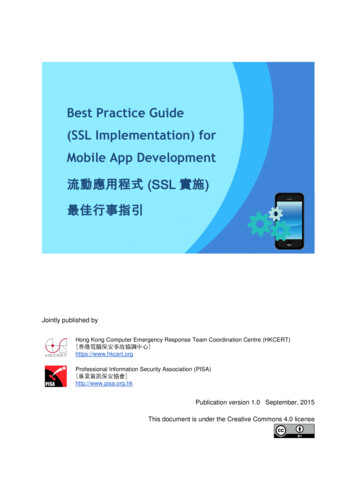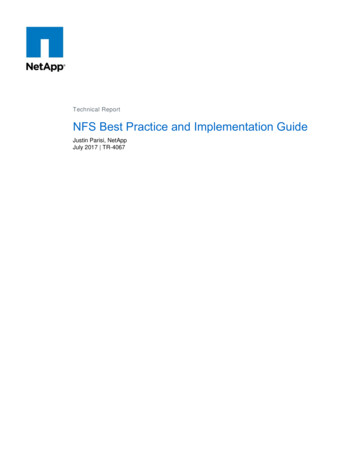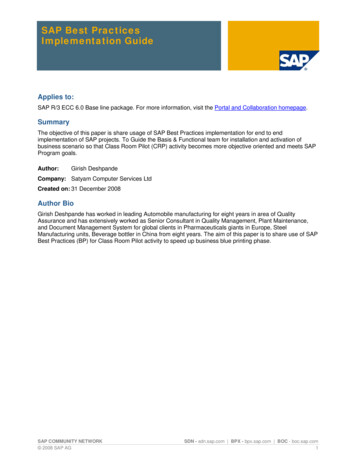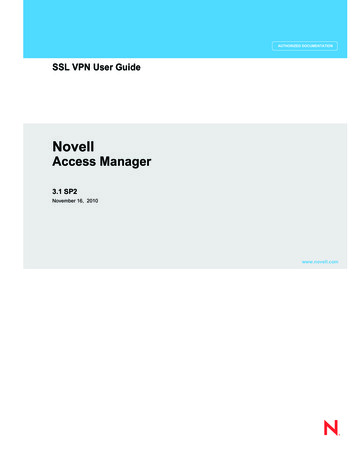
Transcription
Best Practice Guide(SSL Implementation) forMobile App Development流動應用程式 (SSL 實施)實施)最佳行事指引Jointly published byHong Kong Computer Emergency Response Team Coordination Centre s://www.hkcert.orgProfessional Information Security Association g.hkPublication version 1.0 September, 2015This document is under the Creative Commons 4.0 license
ContentAbstract. 3Who should read . 3When to read . 3Relevance of the Personal Data (Privacy) Ordinance to the Security of SSL Implementationin Mobile Application Development . 4Possible reasons of invalidation of SSL . 5Older Mobile Platform . 5Missing Certificate Authority (CA) Certificate . 5Self-signed Certificate . 5Expired Certificate . 5Man-in-the-Middle (MITM) . 5Secure SSL/TLS connection checklist . 6Best Practices . 7General Best Practices . 7iOS Specific Best Practices. 8Android Specific Best Practices . 8Recommendations on Practical Programming . 8Android Scenario 1: Mishandle SSL error in onReceivedSslError function . 9Android Scenario 2: Mishandle validation in a custom TrustManager. 9Android Scenario 3: Allow any hostname in the verification . 11iOS Scenario 1: Allow any HTTPS certificate . 11iOS Scenario 2: Mishandle validation in NSURLConnection and NSURLSession . 12Certificate Pinning . 13Conclusion . 13Page 2
AbstractMobile platform is increasingly become a choice for delivering services. As more sensitive dataand transaction data will be transported on mobile communication channels, the security risksassociated with untrusted communication, such as public Wi-Fi have to be addressed, forexample, fraudster can set up a fake Wi-Fi access point and fake Secure Sockets Layer (SSL)certificates to conduct man-in-the-middle (MITM) attack1 to capture sensitive data.Secure Sockets Layer / Transport Layer Security (SSL/TLS) has been widely used forauthentication and encryption. However, if it is implemented via mobile apps, users have not gotthe same transparency of SSL as in the browser where visual alerts can be given (a colourpadlock icon indicator shown in the address bar). The quality of SSL/TLS implementation inmobile app is thus crucial to detect and deny MITM attacks.This document mentions common practices which help mobile application developers to handleSSL connection with appropriate ways to provide secure channel between mobile app andserver and also prevent from MITM attack.Who should readThis document targets specifically the following parties:1. Mobile app owners who would implement a mobile app service which involvestransmission of sensitive data, such as personal data, credential, and paymentinformation.2. App developers who provide codes for the mobile apps, especially on iOS and Androidplatforms, which make HTTPS connection to the servers on SSL/TLS protocol.When to readThis document should be read:1. before mobile app owners and app developers start planning mobile app developmentproject;2. during the review of the SSL/TLS implementation and verification of coding for themobile app developers.1MITM attack, Wikipedia https://en.wikipedia.org/wiki/Man-in-the-middle attackPage 3
Relevance of the Personal Data (Privacy) Ordinance to the Security of SSLImplementation in Mobile Application DevelopmentData Protection Principles - Security (“DPP4”)2 under the Personal Data (Privacy) Ordinancerequires a data user to take all reasonably practicable steps to implement security precautions,the level of which should be commensurate with the seriousness of the potential harm that couldresult from a data breach.The “Personal data privacy protection: what mobile apps developers and their clients shouldknow”3 stated that data user should consider the use of technological safeguards, includingencrypting personal data being transmitted to prevent unauthorized interception or access.For the effective protection of data via encryption technological, the data user and the mobileapp developer should answer to the following questions:1. Is the transmission of sensitive data properly protected by encryption?2. Is the strength of encryption technology proportional to the security risks associated?For critical services such as financial application, cybercriminals have the incentive touse more advanced attacks to circumvent normal SSL certificate validation. They mighttrick the user to install a fake certificate on to a mobile device. In this case, mobile appowner and developer should consider adopting more advanced technology such asCertificate Pinning4 to combat against such attack.3. Is the encryption properly implemented so that it cannot be easily circumvented?In the mobile app development, SSL/TLS encryption protocol is commonly used toencrypt sensitive data during transmission. There are many ways that a faultyimplementation can give opportunity for attackers. For example, if the mobile app doesnot validate digital certificate for expiry date, the proper signing certificate authority, anduse of strong state-of-art strong encryption algorithm, attacker can use an expiredcertificate, a fake certificate, or a known attack to force the use of a low end encryptionalgorithm.To ensure proper protection of sensitive data in transmission, mobile app owner should putdown the requirements on the selected implementation of encryption and validation of digital2Data Protection Principles, Office of the Privacy Commissioner for Personal Datahttps://www.pcpd.org.hk/english/data privacy law/ordinance at a Glance/ordinance.html#43Personal data privacy protection: what mobile apps developers and their clients should know, Office ofthe Privacy Commissioner for Personal Datahttps://www.pcpd.org.hk/english/resources centre/publications/files/apps developers e.pdf4Certificate Pinning, Wikipedia https://en.wikipedia.org/wiki/HTTP Public Key PinningPage 4
certificate, and verification of implementation into the tender or quotation specification of themobile app development project.For broader consideration on personal data privacy during the design and development ofmobile apps, you may refer to the "Best Practice Guide for Mobile App Development"5 providedby Office of the Privacy Commissioner for Personal Data.Possible reasons of invalidation of SSLOlder Mobile PlatformFor the Android 2.2 or below version, the SSL support contains some issues on Server NameIndication (SNI)6 and Multiple Chain7. It causes SSL connection become invalid, due to therejection of missing intermediate certificate authority (CA) certificate in the older Android system.Missing Certificate Authority (CA) CertificateThe SSL connections of some websites become invalid, because the signed CA certificate maybe missing in the default CA list of the mobile platform.Self-signed CertificateThis situation always occurs during development. A self-signed certificate is commonly used inthe testing environment for testing purpose. Companies and developers are not willing to pay acertificate for internal testing.Expired CertificateExpired certificate is usually a management issue. The administrator of the production websitehas not tracked and updated the digital certificate from time to time. An expired certificate will betreated as untrusted certificate.Man-in-the-Middle (MITM)When attacker conducts a MITM attack, the traffic will be intercepted or redirected. In thissituation, the attacker's self-signed certificate will replace the legitimate certificate. This makesthe SSL connection become invalid.The following figure shows the situation of MITM attack. Attacker can setup a fake Wi-Fi accesspoint. When mobile user connects to the Internet via the access point, MITM intends to intercept5Best Practice Guide for Mobile App Development, Office of Privacy Commissioner for Personal Datahttps://www.pcpd.org.hk/english/resources centre/publications/files/Mobileapp guide e.pdf6Issues on SNI, Google https://code.google.com/p/android/issues/detail?id 129087Issues on Multiple Chain, Google https://code.google.com/p/android/issues/detail?id 26542Page 5
the traffic. If the mobile client (mobile app) does not handle the validation of SSL certificate, aninvalid SSL connection will be made and the MITM can intercept the traffic successfully.Fig 1. MITM attackSecure SSL/TLS connection checklistTo figure out if your mobile app has made a secure connection, mobile app developers shouldcheck the following items:1. Does your mobile app connect to one or more servers in proper encryption?2. Are the SSL certificates in date?3. Are the SSL certificates signed by trusted CA providers or self signed?4. Does the SSL use high enough cipher strengths?5. Does your mobile app accept user-accepted certificates as authorities?By the above questions, mobile app developers should be guided to consider theimplementation of SSL/TLS connection. Firstly, encrypted connection is necessary. Then, avalid SSL connection is established. Strong cipher suites are also required. Finally, anadvanced MITM resistant protection, such as Certificate Pinning8, can be applied to enhancethe security of end-to-end connection.8Certificate Pinning, Wikipedia https://en.wikipedia.org/wiki/HTTP Public Key PinningPage 6
Best PracticesTo prevent from the MITM attack and to build a secure connection, a correct SSLimplementation is necessary. About the network security on mobile, OWASP had issuedguidelines9 to prevent insufficient transport layer protection. This document will highlight the bestpractices on the SSL implementation for mobile developers.General Best Practices Assumption Assume that the network layer is not secure and is susceptible to eavesdropping. Dos Apply SSL/TLS to transport channels that the mobile app will use to transmitsensitive information, session tokens, or other sensitive data to a backend API orweb service.Use strong, industry standard cipher suites with appropriate key lengths, likeSHA256.Use certificates signed by a well-known and trusted CA provider.Always require SSL chain verification. Only establish a secure connection afterverifying the identity of the endpoint server using trusted certificates in the keychain.Alert users through the UI if the mobile app detects an invalid certificate.Account for outside entities like third-party analytics companies, social networks,etc. by using their SSL versions when an application runs a routine via thebrowser/webkit. Avoid mixed SSL sessions as they may expose the user’ssession ID.If possible, apply a separate layer of encryption to any sensitive data before it isgiven to the SSL channel. In the event that future vulnerabilities are discovered inthe SSL implementation, the encrypted data will provide a secondary defenseagainst confidentiality violation.Regular review of security risk and protection level on the mobile app and itsplatform.Don’ts Never allow self-signed certificates, and consider certificate pinning for securityconscious applications. Do not send sensitive data over alternate insecure channels (e.g, SMS, MMS, ornotifications).9Insufficient Transport Layer Protection, OWASPhttps://www.owasp.org/index.php/Mobile Top 10 2014-M3Page 7
iOS Specific Best Practices Do not add code to bypass these defaults to accommodate development hurdlesEnsure that certificates are valid and fail closed.When using CFNetwork, consider using the Secure Transport API to designate trustedclient certificates. To make secure connections, NSStream is used instead of usingsockets directly. In almost all L should be used. If you need towork around compatibility bugs, you can also specify a more specific protocol, such asNSStreamSocketSecurityLevelTLSv1.After development, ensure all NSURL calls (or wrappers of NSURL) do not allow selfsigned or invalid certificates such as the NSURL class methodsetAllowsAnyHTTPSCertificate.Consider using certificate pinning by doing the following: export your certificate, include itin your app bundle, and anchor it to your trust object. Using the NSURL hallenge: will now acceptyour cert.Android Specific Best Practices Remove all code after the development cycle that may allow the application to accept allcertificates such as r SSLSocketFactory.ALLOW ALL HOSTNAME VERIFIER. These are equivalent totrusting all certificates.If using a class which extends SSLSocketFactory, make surecheckServerTrusted method is properly implemented so that server certificate iscorrectly checked.Recommendations on Practical ProgrammingIn general, mobile app developer can implement a secure channel SSL using standard libraryprovided by official Software Development Kit (SDK). Sometimes, mobile developer wouldbypass the validation error during testing; or mobile developer mishandle the validation ofcertificate in the program.The following scenarios10 are commonly found when a developer works on the SSL connectionin Android and iOS 的 SSL 處理, DevCore mobile-app-development/Page 8
Android Scenario 1: Mishandle SSL error in onReceivedSslError functionIf there is a SSL error when WebView connects to a HTTPS server, the functiononReceivedSslError will be triggered. Developer can decide the establishment of theconnection by using handler.proceed() or handler.cancel(). The functionhandler.proceed() will be only used to bypass the error and process the connection intesting environment. handler.cancel() should be used to deny the connection if SSL erroroccurs.Fig 2. Mishandling in onReceiveSslError functionAndroid Scenario 2: Mishandle validation in a custom TrustManagerWith a custom TrustManager, developer may not implement the function ofcheckServerTrusted, then the checking of server's certificate will be bypassed. An invalidSSL connection could be established. Google provided an example code11 to takes a specificCA to create a KeyStore, which is then used to create and initialize a TrustManager. Inaddition, OWASP provided the sample program using custom TrustManager to implementcertificate pinning12.11Security with HTTPS and SSL, Android ticles/security-ssl.html#UnknownCa12Certificate Pinning for Android, OWASPhttps://www.owasp.org/index.php/Certificate and Public Key Pinning#AndroidPage 9
Fig 3. Missing implementation in checkServerTrusted functionFig 4. Example code using KeyStore to create a TrustManagerPage 10
Android Scenario 3: Allow any hostname in the verificationDeveloper may ignore the hostname verification in the SSL session by settingALLOW ALL HOSTNAME VERIFIER or return true in the function. This allows an invalidSSL connection established when the hostname is different from the certificate. It is not a goodpractice. A recommended practice is apply DefaultHostnameVerifier or applyStrictHostnameVerifier in the hostname verification.ORFig 5. Mishandling verification to allow all hostnameiOS Scenario 1: Allow any HTTPS certificateThe function allowsAnyHTTPSCertificateForHost is not allowed and not passed in theApp Store review. To prevent mis-deploy in the development environment, the program is betterto be placed in the block of “#if DEBUG” and ”#endif”. So that, the function is only executedin debug mode.Fig 6. Better to be placed in the block of “#if DEBUG” and ”#endif”Page 11
iOS Scenario 2: Mishandle validation in NSURLConnection and NSURLSessionDeveloper may not implement the checking of certificate in the function NSURLConnectionand NSURLSession, that allows any invalid connection established in the application. This isnot a good practice on SSL implementation. OWASP provided the sample program whenimplement certificate pinning13, which shows the verification of certificate in the iOSdevelopment.Fig 7. No validation of SSL certificate in NSURLConnectionFig 8. No validation of SSL certificate in NSURLSession13Certificate Pinning on iOS, OWASPhttps://www.owasp.org/index.php/Certificate and Public Key Pinning#iOSPage 12
Certificate PinningAttackers might find ways to circumvent digital certificate validation by implanting a fake digitalcertificate into the certificate store of the mobile phone through mobile malware or socialengineering techniques.To prevent such advanced MITM attack, Certificate Pinning is good solutions to ensure theconnection secure with a specific certificate. However, certificate pinning cannot beimplemented in WebView connection yet. To ensure the connection is secure, developersshould not rashly copy the sample code on the Internet and bypass the important validationfunctions. Strict HTTPS implementation code should be followed. Apple iOS14 and GoogleAndroid15 provides network security suggestion for the mobile apps developers. Besides,OWASP issued Top 10 mobile risks, which included network security recommendation.Developers and companies have responsibility to protect the transferring data and provide asecure environment against MITM attack to mobile users.ConclusionSSL encryption is a key technological safeguard to protect sensitive data from unauthorizedinterception or access in transmission. In mobile apps, since there is no visual cue as browsersto warn the users on invalid SSL connection, the responsibility of mobile developer in the properimplementation of SSL should be highlighted.This document has described the best practices with recommendations in practicalprogramming in Android and iOS platforms. We hope that this is useful for mobile developers todevelop good and secure code for the benefits of the community.14Using Networki
Possible reasons of invalidation of SSL Older Mobile Platform For the Android 2.2 or below version, the SSL support contains some issues on Server Name Indication (SNI) 6 and Multiple Chain 7. It causes SSL connection become invalid, due to the rejection of missing intermediate certificate authority (CA)











